July 14 Column: Creative Pest Control
As you probably know, we get plenty of critters in our garden — many of which are certain the garden was planted specifically for them. Sometimes, dealing with them means you need to get creative. This year, Bill and I have found some new methods that are working pretty well. That’s the topic of my column today, which you can find in The Spokesman-Review: Creative garden pest control.
I wanted to share a little more information here, just in case it might help you, too. (and you’ll find this week’s “Everyone Can Grow a Garden” video at the bottom of this post)
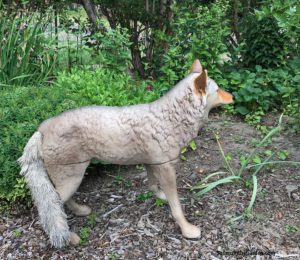 In my column, I mentioned the coyote decoys we saw on the docks on Lake Coeur d’Alene. The purpose was to keep geese from pooping on the docks and I have to say those coyotes looked quite lifelike.
In my column, I mentioned the coyote decoys we saw on the docks on Lake Coeur d’Alene. The purpose was to keep geese from pooping on the docks and I have to say those coyotes looked quite lifelike.
As soon as we got back home, I did a web search for “coyote decoys” and found one sold by Walmart of all places! It cost $65, which I know is a bit of money (and I see they’re now being sold for $80) but it’s made well and boy does it look like a coyote.
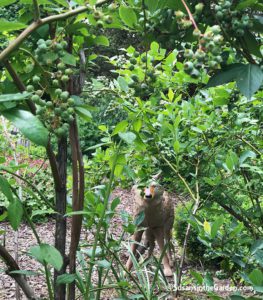 We’ve been moving it around our vegetable garden to keep the quail away from the pea patch and cucamelons, and now “Wile E” (as in, Wile E Coyote, LOL) is guarding the blueberry and strawberry patch. It seems to be making a difference. Although I have to tell you that every time I walk past the area, Wile E startles me because he looks so lifelike! (remember that you can click on any of these photos to view a larger image)
We’ve been moving it around our vegetable garden to keep the quail away from the pea patch and cucamelons, and now “Wile E” (as in, Wile E Coyote, LOL) is guarding the blueberry and strawberry patch. It seems to be making a difference. Although I have to tell you that every time I walk past the area, Wile E startles me because he looks so lifelike! (remember that you can click on any of these photos to view a larger image)
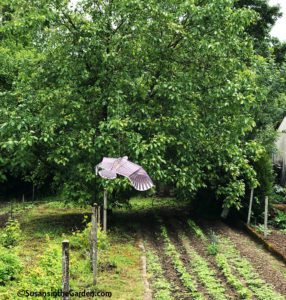 While leading a tour of French gardens recently, we walked past a vegetable garden that had a hawk kite tethered to a pole. You can see what it looked like in the photo at left.
While leading a tour of French gardens recently, we walked past a vegetable garden that had a hawk kite tethered to a pole. You can see what it looked like in the photo at left.
A light breeze was blowing and that kite really looked like a hawk hovering in the garden. I pointed it out to Bill and immediately made a mental note to check into them when we got back to Spokane.
Well, I did find one on Amazon that looks remarkably like a red-tailed hawk. It cost $19, which seemed reasonable, so we ordered one. Bill figured out a way to suspend it over the orchard because the darned robins keep eating our ripening cherries. As you can see by the video below, it really looks good… although it’s been quite windy lately, so Mr. Hawk is getting quite the workout! But we are very impressed with it and are so glad we saw it in action in that French garden.
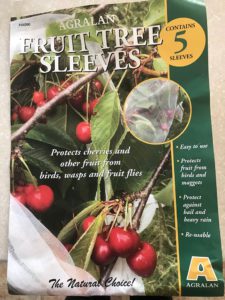 When I was at the Chelsea Flower Show last year, I stopped by the Agralan vendor booth as I noticed they sold a lot of organic products. It’s always good to learn about new methods, right?
When I was at the Chelsea Flower Show last year, I stopped by the Agralan vendor booth as I noticed they sold a lot of organic products. It’s always good to learn about new methods, right?
One of their products really got my attention: fruit tree sleeves (see photo). Made from a very fine, but durable, nylon mesh, they are made for covering the branches of cherry trees and other fruits to keep birds, wasps and cherry fruit flies away. Eureka! I decided to purchase a package of 5 sleeves. Yes, I know our cherry trees have way more than 5 branches, but I really wanted to try them out.
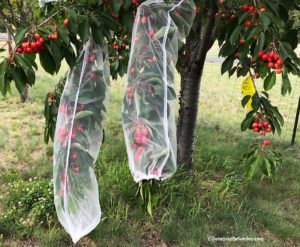 The sleeves are about 10″ wide by about 36″ long, and are open on each end. You slip a sleeve up over a branch and loosely cinch up each end with the draw strings. We’ve put them onto the branches on a couple of trees and I think it’s going to work GREAT! I’m very excited about this.
The sleeves are about 10″ wide by about 36″ long, and are open on each end. You slip a sleeve up over a branch and loosely cinch up each end with the draw strings. We’ve put them onto the branches on a couple of trees and I think it’s going to work GREAT! I’m very excited about this.
According to the information, you can put the sleeves in place once the blossoms have dropped and the small cherries start to develop.
Unfortunately, the fruit tree sleeves are only available in the U.K., although I would guess you could order them and pay them to ship the sleeves to the U.S. But because they’re not available locally, I’m toying with the idea of sewing a few more sleeves using floating row cover instead of the mesh.
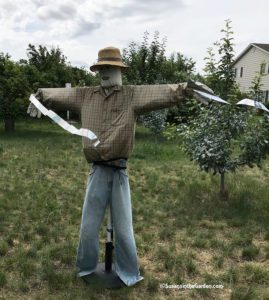 You might also recall that we made a scarecrow named “Digby” a few weeks back (see video). That was a fun project and it seems to be helping but some birds aren’t all that worried about him! You’ll in the photo that Bill has added a bit of flash tape to Digby’s arms in the hopes of making him a bit more scary.
You might also recall that we made a scarecrow named “Digby” a few weeks back (see video). That was a fun project and it seems to be helping but some birds aren’t all that worried about him! You’ll in the photo that Bill has added a bit of flash tape to Digby’s arms in the hopes of making him a bit more scary.
The following methods that we also employ are not new to us. We’ve been using them for years and they are also helpful:
Flash tape _ This wide mylar ribbon flashes and rustles in the breeze (see on Digby). It is very effective and if you take good care of it, the ribbon will last for years. Even though it is referred to as a “tape,” it doesn’t have any adhesive on it. We use the 2″ wide ribbon.
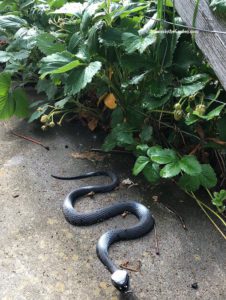 Toy snakes _ These rubber snakes make visitors to our garden jump on occasion but they’re totally harmless! We bought a bunch at the dollar store to use as a deterrent to keep quail and other birds away from freshly-sprouted seeds as well as plants they love to nibble on. They work pretty well. Just remember to move them from time to time.
Toy snakes _ These rubber snakes make visitors to our garden jump on occasion but they’re totally harmless! We bought a bunch at the dollar store to use as a deterrent to keep quail and other birds away from freshly-sprouted seeds as well as plants they love to nibble on. They work pretty well. Just remember to move them from time to time.
Important things to remember:
Move these deterrents around. If you keep them in the same place day after day, birds and other critters will realize there’s nothing to fear and go right back to being bothersome.
Put the deterrents in place right when you need them and remove them as soon as you don’t, so pests don’t get habituated to them. This is REALLY important, folks! For example, as soon as we’ve harvested our cherries, the mylar ribbon, hawk kite and fruit tree sleeves will be put away… although we fully intend to relocate the hawk kite to the blueberry patch so it can work its robin- and starling-repellent magic and protect our crop.
OK, here is this week’s video. The topic? What we’re growing to attract pollinators. This includes an update of the new pollinator garden we added to the front yard in May.
